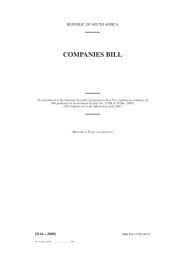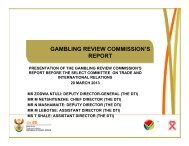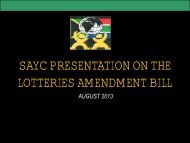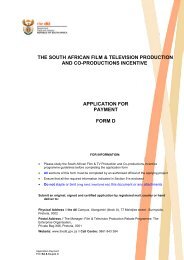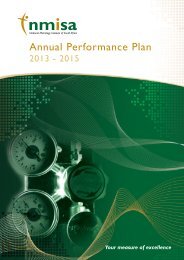Copyright Review Commission Report - ICT Law and Regulation ...
Copyright Review Commission Report - ICT Law and Regulation ...
Copyright Review Commission Report - ICT Law and Regulation ...
- No tags were found...
Create successful ePaper yourself
Turn your PDF publications into a flip-book with our unique Google optimized e-Paper software.
administration of rights was felt by composers <strong>and</strong> music publishers from the end of the second quarter of the19th century as regards the performance of non-dramatic music works in places of public entertainment.5.1.3. The establishment of the first collective licensing body predates the adoption of the Berne Convention for theProtection of Literary <strong>and</strong> Artistic Works in 1886. In France in 1852, SACEM (a society of authors, composers<strong>and</strong> music publishers) was established to administer public performance rights in musical works. Following theadoption of the Berne Convention, which recognises the public performance as a principal feature of theprotection to be afforded to all authors from the Berne Union countries, it became apparent to authors in manyother countries that in practice it was impossible to safeguard such a right on an individual basis. By the turn ofthe century, technical developments led to the advent of new categories of works protected by copyright.Following the recognition of public performance rights in sound recordings, collecting societies were establishedto represent authors <strong>and</strong> performers in countries that recognise these rights. The emergence of radio <strong>and</strong>television broadcasting as a major user of copyright works in the first half of the 20th century, as well as othernew technologies that have developed in the interim <strong>and</strong> given rise to new users of work (such as reprography,satellite transmission <strong>and</strong> cable distribution, commercial rental, computer storage of protected works indatabase, digital storage <strong>and</strong> distribution of works via Internet) have led to the extension of collecting societiesto new areas.5.1.4. The term ‘collecting society’ is generally used to describe the organisations set up by the various categories ofrights owners to administer their rights collectively. The EU <strong>and</strong> UK definitions differ, but still amount to thesame thing. The EU definition reads “any organisation which manages or administers copyright or rights relatedto copyright as its sole purpose or as one of its main purposes”. In the UK, the term ‘licensing body’ is used todescribe a society or other organisation which has as its main purpose the negotiation or granting (either asowner or agent for the owner) of copyright licences, <strong>and</strong> whose objectives include the granting of licencescovering works of more than one author.5.1.5. In the UK <strong>and</strong> some EU member states, collecting societies or licensing bodies are private organisationsestablished <strong>and</strong> controlled by the rights owners themselves. However, in other countries, for the protection ofthe public, there is some kind of government supervision or control over the practices of these societies. The1988 Act of the UK provides a regulatory framework for the operation of the licensing bodies in certain areas<strong>and</strong> also provides for the <strong>Copyright</strong> Tribunal. In general, whether collecting societies are governmentsupervisedor privately owned, some degree of control by the government is imminent as is evident in a countrylike South Africa. Overall, collecting societies are established on six key principles:1) To do for members of collecting societies what they cannot practically <strong>and</strong> economically do for themselves,by providing a service to enable rights owners to enforce <strong>and</strong> administer certain of their copyrightseffectively <strong>and</strong> cheaply;2) To provide a service to users by facilitating access to copyright works <strong>and</strong> making it possible for users tocomply with their obligations under the copyright law;3) To guarantee users immediate access to the licensor’s repertoire;4) To keep administration costs incurred by users <strong>and</strong> owners as low as possible;5) To provide for the use of copyright of recordings that have yet to be made; <strong>and</strong>6) To meet the needs of owners <strong>and</strong> users whatever the scale of their business.5.1.6. The CRC is satisfied that the establishment of collecting societies is the best available mechanism for licensingcopyright works.- 39 -





